

GENERAL
Origin
:
sub-tropical,
tropical
Vigour
:
normal growth
rate
Humidity
:
extremely arid,
very arid
Propagation :
sowing and
pricking out
Maintenance :
low
CONDITIONS
Urban climate :
resistant
Dessication :
resistant
Stagnant water :
vulnerable
Irrigation
:
low
Salinity/ppm :
moderate (2500
ppm)
Hardiness
:
-6°C
SHAPE
Type
:
tree, shrub
Height
:
7 m
Spread
:
12 m
Foliage
:
semi-evergreen
FLOWER
Colour
:
yellow
Size
:
1.5 cm
Period
:
February - April
Smell
:
pleasantly
scented, flower
FRUIT
Type of fruit :
pod
Fruit size
:
10 cm
A common, large and spiny, desert shrub or small tree, on the Arabian Peninsula, A. ehrenbergiana
is known in Arabic as salam, and grows in groups in depressions and wadis, where rainwater
runoff and fine waterborne sediment collect. The tree usually has multiple branches from the
ground, with a greenish-brown, peeling bark, similar to that of Acacia seyal, with which it can
be confused. In comparison, the whitish thorns of A. ehrenbergiana are longer than the leaves.
Flowers are borne in yellow heads; seed pods are long, up to 10 cm. The tree has many uses in the
desert: it is browsed by camels, pollarded for stock, produces an edible gum, is used for firewood
and fodder; fibre ropes are made from the bark, and a liquid medicine known as Qataran is
extracted for use in treating animal and human skin parasites. The heavy fluid is also used to
protect the trunks of fruit trees from insects and fungi. A. ehrenbergiana regrows well from cut
stumps, and can be propagated by seed mixed with animal manure, which helps acacia seeds to
germinate better. The tree is famously used in beekeeping, producing good-quality salam honey.
The trees usually grow randomly about 5 metres apart. One of the most drought-tolerant of
acacias, it can gradually be weaned off watering altogether, after initial irrigation during the first
year after planting. High growth rates occur during a heavy rain season. Owing to its drought
tolerance, the tree can be planted in extensive landscape schemes, where a natural desert setting
is the objective.
22
Acacia ehrenbergiana,
Mimosaceae
Selim Acacia,
as salam
















